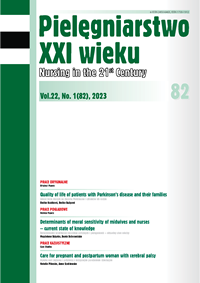Care for pregnant and postpartum woman with cerebral palsy
DOI:
https://doi.org/10.2478/pielxxiw-2023-0007Keywords:
pregnancy, sexuality, disability, Cerebral palsyAbstract
CARE FOR PREGNANT AND POSTPARTUM WOMAN WITH CEREBRAL PALSY
Introduction. Disabled women are often overlooked when it comes to procreation plans and encounter social misunderstanding and lack of support. In addition, their sexual needs are often marginalized. It means that education and professional care of midwives and doctors are necessary to put flesh on problem.
Aim. The aim of the work is to present knowledge and familiarize with the subject of perinatal care for a woman with a disability based on an individual case study.
Method. For the purposes of this study, the qualitative research method “study case” was used, containing a description of the patient’s obstetric and clinical condition, aimed at its in-depth analysis and assessment. The patient’s informed consent to participate in the study was obtained. C-Hobic care outcome indicators were also used to describe the case. ICNP® reference terminology was used to develop care plans.
Summary. Taking care of a patient with cerebral palsy, the midwife undertakes numerous interventions in the field of education of both the woman and the whole family. The overriding goal is to increase the woman’s independence, increase her confidence that she will be able to take care of a newborn and improve her competence in self-care. Due to the constant progress in maternal-fetal medicine, further research is needed on preconception and perinatal care for patients with CP.
References
1. Filax G TD. Disabled Mothers: Stories and Scholarship By and About Mother with Disabilities. Disabled Mothers. 2014; 1: 7-14.
2. Rintala D, Young ME, Chanpong GF. National Study of Women With Physical Disabilities: Final Report. Sexuality and Disability. 2001; 1: 9-21.
3. Krahn G. A Call for Better Data on Prevalence and Health Surveillance of People With Intellectual and Developmental Disabilities. Intellectual and Developmental Disabilities. 2019; 5(57): 357-375.
4. Hayward K, Chen AY, Forbes E, et al. Reproductive healthcare experiences of women with cerebral palsy. Disability Health Journal. 2017; 10: 413-418.
5. Warowna M, Tokarczyk K, Hordyjewska A. BK. Styl życia oraz zmiany ogólnoustrojowe u kobiet w ciąży. Kosmetologia Estetyczna. 2019; 1: 1-6.
6. Iezzoni LI, Yu J, Wint AJ, et al. Prevalence of Current Pregnancy Among U.S. Women with and without Chronic Physical Disabilities. Med. Care. 2013; 51: 555.
7. Iezzoni LI, Yu J, Wint AJ, et al. Conditions Causing Disability and Current Pregnancy Among U.S. Women with Chronic Physical Disabilities. Med. Care. 2014; 52: 20.
8. Iezzoni LI, Yu J, Wint AJ, et al. General health, health conditions, and current pregnancy among U.S. women with and without chronic physical disabilities. Disability Health Journal. 2014; 7: 181-188.
9. Mitra M, Long-Bellil LM, Iezzoni LI, et al. Pregnancy among women with physical disabilities: Unmet needs and recommendations on navigating pregnancy. Disability Health J. 2016; 9: 457-463.
10. Iezzoni LI, Wint AJ, Smeltzer SC, et al. ‘how did that happen?’ Public responses to women with mobility disability during pregnancy. Disability Health Journal. 2015; 8: 380-387.
11. Michałowicz R. Mózgowe porażenie dziecięce. Warszawa: PZWL Wydawnictwo Lekarskie. 2001; s. 10-20.
12. Sear R, Lawson DW, Kaplan H, et al. Understanding variation in human fertility: What can we learn from evolutionary demography? Philos. Trans. R. Soc. B. Biol Sci. 371. Epub ahead of print 2016. DOI: 10.1098/rstb.2015.0144.
13. Smeltzer SC. Pregnancy in Women With Physical Disabilities. Journal Obstet. Gynecol. Neonatal. Nurs. 2007; 36: 88-96.
14. Hryniewicz-Czarnecka M. Mózgowe porażenie dziecięce studium przypadku. Warszawa:Wydawnictwo CzytaMisie; 2021, s. 8-26.
15. Turk MA, Overeynder JC, Matthew Janicki AP. Aging and cerebral palsy-clinical concerns a report of the workgroup on aging and cerebral palsy New York State Developmental Disabilities Planning Council; 1995, p. 7-15.
16. Sundelin H, Stephansson O, Johansson S. Pregnancy outcome in women with cerebral palsy: A nationwide population-based cohort study. Acta. Obs. Gynecol. Scand. 2020; 99: 518-524.
17. Rogers J. The Disabled Woman’s Guide to Pregnancy and Birth. Demoss Medical Publishing; 2006, p. 50-61.
18. Clinic M. Mayo clinic quide to a healthy pregnancy „Postpartum depression”, 2015.
19. Kilańska D. Wskaźniki jakości opieki i ich wykorzystanie w praktyce. Zasady korzystania z narzędzi, ewaluacja i walidacja skal oceny statusu zdrowotnego. Akredytowane Cent Rozw ICNP przy Uniwersytecie Medycznym w Łodzi, 2015, s. 1-10.
20. ICNP® - polski. https://www.icn.ch/sites/default/fi les/inline-fi les/icnp-polski_translation. pdf Accessed 30 Dec. 2022
21. ISO - ISO 18104:2003 - Health informatics - Integration of a reference terminology model for nursing, https://www.iso.org/standard/33309.html Accessed 30 Dec. 2022
22. Przeglądarka ICNP | ICN – Międzynarodowa Rada Pielęgniarek, https://www.icn.ch/what-we-do/projects/ehealth-icnptm/icnp-browser Accessed 30 Dec. 2022.
Downloads
Published
Issue
Section
License
Copyright (c) 2023 Authors

This work is licensed under a Creative Commons Attribution 4.0 International License.




